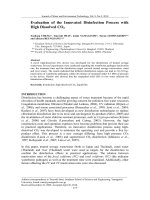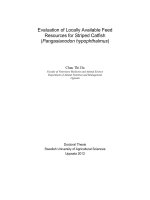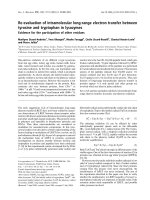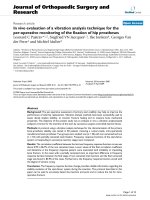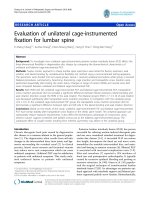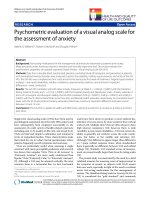Evaluation of ginger (Zingiber officinale) genotypes for high yield and resistance to soft rot suitable for Gudalur regions in Nilgiris district
Bạn đang xem bản rút gọn của tài liệu. Xem và tải ngay bản đầy đủ của tài liệu tại đây (213.7 KB, 7 trang )
Int.J.Curr.Microbiol.App.Sci (2018) 7(7): 2979-2985
International Journal of Current Microbiology and Applied Sciences
ISSN: 2319-7706 Volume 7 Number 07 (2018)
Journal homepage:
Original Research Article
/>
Evaluation of Ginger (Zingiber officinale) Genotypes for High Yield and
Resistance to Soft Rot Suitable for Gudalur Regions in Nilgiris District
S. Karthikeyan1*, M. Anand1, S. Malathi1 and S. Manonmani2
1
Horticultural Research Station, Tamil Nadu Agricultural University,
Ooty, The Nilgiris, India
2
Department of Oilseeds, TNAU, Coimbatore, India
*Corresponding author
ABSTRACT
Keywords
Evaluation, Ginger,
Gudalur, Genotypes,
High yield, Soft rot
resistance
Article Info
Accepted:
20 June 2018
Available Online:
10 July 2018
The experiment was conducted to assess the performance of ginger
genotypes suitable for high yield and resistance to soft rot disease in
Gudalur block of The Nilgiris district. Fourteen genotypes were collected
and the performance was studied for three seasons during the year 2015 2018. Acc-578 showed better performance in terms of vegetative and yield
characters followed by Mahima. IISR-1 GB, Maran and Thadimaran
recorded moderate resistance to per cent disease incidence under field
conditions in the Nilgiris.
Introduction
Ginger (Zingiber officinale Rosc.) is a
herbaceous perennial, belonging to the family
Zingiberaceae, valued for its aroma, flavour
and medicinal properties. It is a major spice
crop of which the rhizomes are used as spice.
India is one of the leading producers of ginger
in the world accounting for 50 % of the world
total production. Ginger is cultivated in most
of the states in India. Kerala, Meghalaya,
Arunachal Pradesh, Mizoram, Sikkim,
Nagaland and Odisha together contribute 70
per cent of the country’s total production.
Ginger is grown in the Gudalur and Pandalur
taluks of the Nilgiris district, Tamil Nadu in
an area of 415.87 ha adjoining the state of
Kerala (2017, Nilgiris Horticulture database).
Gudalur block is a heavy rainfall receiving
zone in the Nilgiris district and receives an
average of 2000 mm per year. The average
temperature ranges from 20o to 35o C in
Gudalur. The farmers of the Gudalur block of
Nilgiris district cultivate the crop during the
month of March to November.
Ginger is propagated commercially by
vegetative method and chance of crop
improvement programme is very limited. In
such cases, alternate method is to collect,
2979
Int.J.Curr.Microbiol.App.Sci (2018) 7(7): 2979-2985
conserve and evaluate the different varieties
grown under the diverse conditions suitable
for specific agro-climatic conditions. The
yield and quality of different ginger varieties
varies according to the temperature and
elevation. The soft rot disease caused by
Pythium aphanidermatum in ginger is a major
problem. The occurrence of per cent disease
incidence in Gudalur regions is upto 40%. It is
basic need to develop high yielding varieties
with better quality to increase the production
and productivity of ginger in India. The
varieties Maran, Thadimaran and Rio-deJanerio are mostly cultivated in Gudalur
regions. The average yield obtained by the
farmers from these varieties is 12.50 tonnes
per hectare. The study was planned to collect
different varieties of ginger genotypes and to
evaluate the performance of the accessions for
high yield and resistance to soft rot disease
suitable for Gudalur regions of the Nilgiris
district.
Materials and Methods
A field experiment was conducted for three
seasons to evaluate the performance of
collected genotypes at Hybrid Rice Evaluation
Centre, Tamil Nadu Agricultural University
Gudalur, The Nilgiris district during the year
2015 - 2018. A total of fourteen genotypes of
ginger from Indian Institute of Spices
Research, Calicut and local collections from
Gudalur areas were collected and planting was
taken up during the month of May, 2015
during the first season. Protray nursery
techniques was followed for sprouting of
rhizomes and after one month; sprouted, well
grown plantlets were transplanted in main
field. Field was prepared and planting of
uniform sprouted rhizomes of 30 - 40 grams
size was taken up with a spacing of 20 x 20
cm between the rows and in between the
plants. The performance of the collected 14
genotypes was assessed for its important
growth and yield characters for the three
season crop. Data on the morphological and
yield parameters were collected from mean of
randomly selected five plants from each
genotype in each replication. The vegetative
and yield parameters viz., plant height (cm),
number of leaves per plant, number of tillers
per plant, individual rhizome weight (kg),
yield per plot (kg), length and girth of the
rhizome (cm) were recorded at critical stages
of crop growth. The vegetative parameters
observed during 150 days after planting was
recorded and presented in the table for
interpretation.
Screening studies on the resistance to soft rot
disease were carried out in pot culture and
observed in field conditions. The per cent
disease incidence (PDI) was calculated by
counting the number of plants affected per
plot divided by total number of plants in each
plot multiplied by 100. First observation was
taken up four months after sowing at tillering
stage. After a fortnight, second observation
was taken up at active tillering stage. Third
observation was taken up at the beginning of
rhizome bulking stage. Mean of three
observations were recorded as annual PDI of
each varieties (Senapati and Sugata Ghose,
2005). The varieties were grouped based on
the percentage of resistance. The ginger
genotypes namely ACC – 578, Mahima,
Athira, Aswathi, IISR - 1 GB, GCP – 49,
Rejetha, Varada, ACC-581, Karthika, Maran,
Thadimaran, Rio-de-janerio, Gudalur local
were collected. The treatment was laid out by
randomized block design with two
replications. The crop cultivation was done by
following the standard package of practices
recommended in crop production guide. The
data collected were statistically analyzed by
following the procedure of Panse and
Sukhatme (1967).
Results and Discussion
The results of the experimental study taken up
during the three years were discussed and
interpreted based on the performance of the
2980
Int.J.Curr.Microbiol.App.Sci (2018) 7(7): 2979-2985
genotypes. The Table 1 shows significant
variations among the genotypes for important
growth and yield attributes for the crop grown
during 2015-2016. Among the fourteen types
collected and evaluated, the plant height in
Acc - 578 recorded maximum (43.20 cm)
followed by Rio-de-janerio (41.70 cm),
Gudalur local (41.40 cm) and the least plant
height was noticed in Karthika (15.40 cm).
The plant height of different accessions ranged
between 15.40 cm to 43.20 cm. The genotype
Gudalur local recorded maximum number of
leaves per plant (229.80) followed by Rio-dejanerio which recorded 204.00. The number of
tillers per plant was maximum in Gudalur
local (19.80). The individual weight of
rhizome in the variety Rio-de-janerio recorded
maximum weight of 232.00 g and yield per
plot (4 m2) of
10.10 kg. Karthika
recorded lowest individual rhizome yield of
16.00 g per plot. The varieties Athira (0.68
kg), ACC-581 (0.21 kg), Karthika (0.12 kg)
recorded lowest yield per plot during the first
season.
The mean of second and third season data
(2016 - 2017 & 2017 - 2018) was combined in
Table 2 and the results are interpreted.
Significant variations were observed in terms
of vegetative, yield and resistance to soft rot
incidence grown under Gudalur condition.
Acc - 578 recorded maximum plant height
(78.75 cm) followed by Mahima (72.15 cm)
and lowest plant height was recorded in
Karthika (24.40 cm). More number of leaves
per plant (113.70) was recorded in Acc-578.
GCP-49 recorded maximum number of tillers
per plant (17.40) followed by Acc-578 (15.0)
during 150 days after planting for the
vegetative parameters. Mahima recorded
maximum girth of rhizome (3.75 cm) and
lowest in ACC-581 (1.60 cm).
Table.1 Performance of genotypes for vegetative and yield characters during the first crop
(2015 - 2016)
S.
No.
Genotypes/
Collections
1.
2.
3.
4.
5.
6.
7.
8.
9.
10.
11.
12.
13.
14.
ACC - 578
Mahima
Athira
Aswathi
IISR - 1 GB
GCP - 49
Rejetha
Varada
ACC-581
Karthika
Maran
Thadimaran
Rio-de-janerio
Gudalur local
Mean
SE(d)
CD (0.05)
Plant height
@ 150 DAP
43.20
33.70
30.20
30.80
30.00
34.40
30.40
37.60
30.20
15.40
31.70
33.00
41.70
41.40
33.12
1.37
2.96
Number of leaves
per plant @ 150
DAP
134.40
102.60
91.80
96.20
91.60
104.20
84.40
112.60
97.00
59.80
101.00
152.00
204.00
229.80
118.67
1.68
3.64
* DAP - Days after planting
2981
Number of
tillers/plant
@ 150 DAP
10.20
8.80
7.80
8.60
7.20
8.80
7.40
10.60
9.80
5.60
7.80
11.80
18.60
19.80
10.20
0.47
1.01
Individual
rhizome
weight (g)
170.50
151.00
48.50
90.50
99.50
168.00
95.00
94.00
67.50
16.00
196.00
179.50
232.00
42.50
117.89
1.27
2.75
Yield per
plot (kg)
(4 x 1 m)
8.55
3.27
0.68
2.14
3.00
4.47
1.23
2.93
0.21
0.12
3.57
4.71
10.10
1.67
3.33
0.15
0.33
Int.J.Curr.Microbiol.App.Sci (2018) 7(7): 2979-2985
Table.2 Mean performance of ginger genotypes for vegetative and yield characters during
the second and third season crop (2016 - 2018)
S.
No.
1.
2.
3.
4.
5.
6.
7.
8.
9.
10.
11.
12.
13.
14.
Genotypes/
Collections
ACC - 578
Mahima
Athira
Aswathi
IISR - 1 GB
GCP - 49
Rejetha
Varada
ACC-581
Karthika
Maran
Thadimaran
Rio-de-janerio
Gudalur local
Mean
SE(d)
CD (0.05)
Plant Number of
height leaves per
@
plant @
150
150 DAP
DAP
78.75
113.70
72.15
77.23
39.15
83.56
49.70
94.34
61.45
96.85
57.50
107.28
46.45
80.10
50.15
51.28
30.50
21.08
24.40
12.26
45.80
48.24
54.45
81.71
36.95
29.68
41.15
64.09
49.18
68.67
1.58
3.46
1.98
6.78
Number
of tillers/
plant@
150 DAP
Length
of
rhizome
(cm)
15.00
13.35
7.80
10.90
8.95
17.40
8.10
7.65
4.40
4.50
9.40
10.30
6.20
11.75
9.70
0.46
0.39
31.00
23.50
23.00
33.50
25.00
32.00
23.50
26.50
21.25
18.50
29.00
31.75
32.00
25.00
26.72
0.62
0.54
Girth of
rhizome
(cm)
3.65
3.75
1.95
3.43
2.75
2.95
2.85
2.18
1.60
1.75
2.50
3.18
3.80
3.35
2.83
0.88
0.70
Weight of
individual
rhizome
(g)
696.40
384.30
154.40
504.90
291.15
308.65
252.40
163.65
74.80
76.75
265.25
417.75
442.30
269.30
307.29
17.72
15.01
* DAP - Days after planting
Table.3 Screening of ginger varieties against rhizome rot disease under invitro culture
S. No
1
2
3
4
5
6
7
8
9
10
11
12
13
14
Variety
Varada
GCP-49
Thadimaran
Rio-de-Janerio
Rejetha
Acc -578
Acc - 581
Athira
Aswathi
IISR-1 GB
Gudalur local
Mahima
Karthika
Maran
2982
PDI
30.21
28.64
11.26
3.92
4.12
7.61
18.72
19.56
35.64
4.21
9.42
20.16
19.84
3.12
Fresh
rhizome
yield per
plot (g)
(6x1m)
20.00
15.50
1.97
11.65
14.00
15.75
7.75
2.53
0.43
0.32
9.75
10.05
8.35
2.80
8.64
0.76
0.66
Int.J.Curr.Microbiol.App.Sci (2018) 7(7): 2979-2985
Grouping of ginger varieties screened against rhizome rot
PDI
0.0
1.0 to 5.0
Category
Resistant
Moderately resistant
6.0 to 15.0
Tolerant
16.0 to 25.0
Moderately tolerant
26.0 to 40.0
above 40
Susceptible
Highly susceptible
Name of variety
Rejetha, Maran, Rio-de Janerio,
IISR-1GB
Acc 578, Gudalur local,
Thadimaran
Acc- 581, Athira, Mahima,
Karthika
Aswathi, Varada, GCP-49
-
Table.4 Screening of ginger varieties against rhizome rot disease under field condition
S. No
1
2
3
4
5
6
7
8
9
10
11
12
13
14
Variety
ACC - 578
Mahima
Athira
Aswathi
IISR - 1 GB
GCP - 49
Rejetha
Varada
ACC-581
Karthika
Maran
Thadimaran
Rio-de-janerio
Gudalur local
PDI
10.00
21.00
19.50
29.00
5.00
38.00
12.00
36.50
18.00
42.50
3.50
4.50
25.00
11.00
Grouping of ginger varieties screened against rhizome rot
PDI
0.0
1.0 to 5.0
6.0 to 15.0
16.0 to 25.0
Category
Resistant
Moderately resistant
Tolerant
Moderately tolerant
26.0 to 40.0
above 40
Susceptible
Highly susceptible
2983
Name of variety
IISR - 1 GB, Maran, Thadimaran
ACC – 578, Rejetha, Gudalur local
Mahima, Athira, ACC-581,
Rio-de-janerio
Varada, GCP - 49
Karthika
Int.J.Curr.Microbiol.App.Sci (2018) 7(7): 2979-2985
Aswathi recorded maximum length of
rhizome (33.50 cm) followed by GCP-49
(32.0 cm) and lowest in Karthika (18.5 cm).
Rio-de-janerio Acc-578 recorded 20.0 kg of
fresh rhizome yield per plot (6 m2), weight of
individual rhizome (696.40 g). The lowest
fresh rhizome yield per plot was recorded in
Karthika (0.32 kg per plot). The highest fresh
rhizome yield produced by some of these
varieties can be mainly attributed to
vegetative growth characters like plant height,
number of leaves per plant, fresh weight of
rhizomes, length of rhizome and girth of
rhizome. It can be attributed that the yield of a
variety is dependent on vigour of the plant
and other rhizome characters (Sanwal et al.,
2012; Chongtham et al., 2013; Raviraja
Shetty et al., 2015).
Reaction to per cent disease incidence
against soft rot resistance
The per cent disease incidence of the
genotypes was assessed based on the
performance of each genotype with respect to
its resistance to soft rot under in vitro and in
vivo conditions. The genotypes IISR - 1 GB,
Maran, Thadimaran were found to be
moderately resistant which ranges between
1.0 to 5.0. The genotypes ACC -578, Rejetha,
Gudalur local were found to be tolerant under
the category of 6.0 to 15.0. The genotypes
Mahima, Athira, ACC-581,
Rio-dejanerio were found to be moderately tolerant
under the category of 16.0 to 25.0.
Varada, GCP - 49 expressed susceptible with
a score of 26.0 to 40.0. Aswathi recorded
maximum percent disease incidence of 35.64
and Maran recorded minimum percent disease
incidence of 3.12 under invitro culture
experiment (Table 3).
The variety Maran recorded minimum per
cent disease incidence (PDI) of 3.50 and
Karthika recorded maximum per cent disease
incidence under field experiment. The
accessions IISR-1GB, Maran, Thadimaran
expressed moderate resistant (1.0 to 5.0),
Acc-578, Rejetha and Gudalur local (6.0 to
15.0) recorded tolerance to soft rot incidence.
The varieties Mahima, Athira, Acc-581, Riode-janerio recorded moderate resistance (16.0
to 25.0) and Varada,
GCP-49 were
susceptible (26.0 to 40.0) to soft rot. The
variety Karthika was highly susceptible to
soft rot disease of ginger under Gudalur
conditions (Table 4).
In conclusion, the overall performance of
Acc-578 recorded better for vegetative and
yield parameters followed by Mahima. IISR-1
GB, Maran and Thadimaran recorded
moderate resistance with low per cent disease
incidence under field conditions in the
Nilgiris.
Acknowledgement
The authors gratefully thank and acknowledge
Dr. Prasath, Principal Scientist, ICAR - Indian
Institute of Spices Research, Calicut for
providing genotypes and varieties to take up
the evaluation study and Professor & Head,
Hybrid Rice Evaluation Centre, Gudalur for
providing support for carrying out the
research work.
References
A.K. Senapati and Sugata Ghose, 2005.
Screening of ginger varieties against
rhizome rot disease complex in eastern
ghat high land zone of Orissa Indian
Phytopath. 58 (4): 437-439.
Chongtham,T., Chatterjee, R., Hnamte, V.,
Chattopadhyay, P.K. and Khan, S.A.
2013. Ginger (Zingiber officinale
Rosc.) germplasm evaluation for yield
and quality in southern West Bengal,
J. Spices and Aromatic Crops, 22(1):
88-90.
Panse, V. G. and Sukhatme, P. V. 1967.
2984
Int.J.Curr.Microbiol.App.Sci (2018) 7(7): 2979-2985
Statistical Methods for Agriculture
Workers.
Indian
Council
of
Agricultural Research. New Delhi.
p.155.
Raviraja Shetty, G., Kallappa Narode and
Venkatesha. J. 2015. Performance of
ginger (Zingiber officinale Rosc.)
varieties under hill zone of Karnataka.
Environ. and Ecol., 33(3): 1196-2000.
Sanwal, S.K., Singh, S.K., Yadav, R.K.,
Singh. P.K and Misra. A.K. 2012.
Yield and quality assessment of ginger
(Zingiber officinale Rosc.) genotypes.
Indian J. plant Genet. Resour., 25(3):
281-286.
How to cite this article:
Karthikeyan, S., M. Anand, S. Malathi and Manonmani, S. 2018. Evaluation of Ginger
(Zingiber officinale) Genotypes for High Yield and Resistance to Soft Rot Suitable for Gudalur
Regions in Nilgiris District. Int.J.Curr.Microbiol.App.Sci. 7(07): 2979-2985.
doi: />
2985
